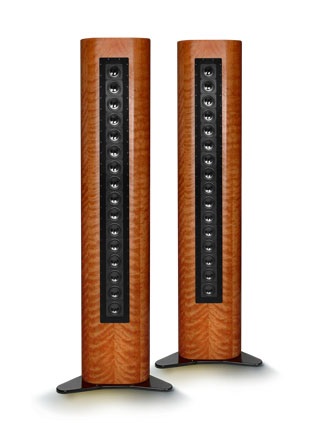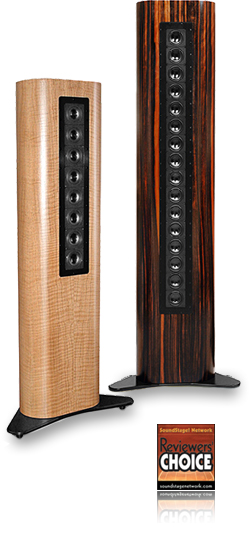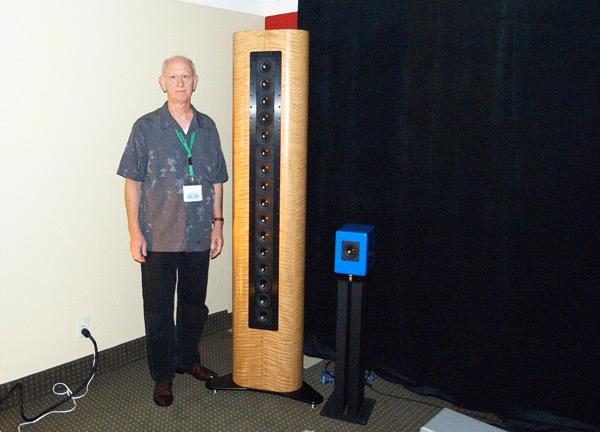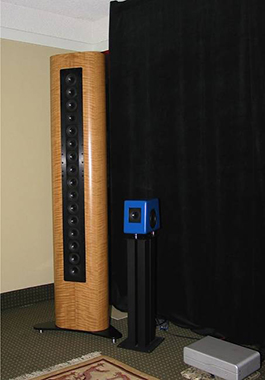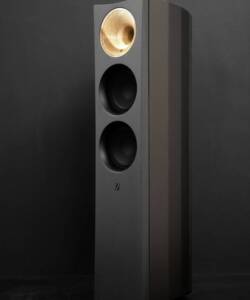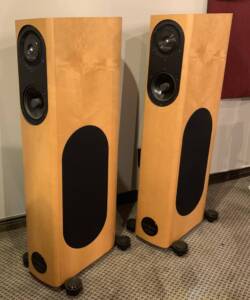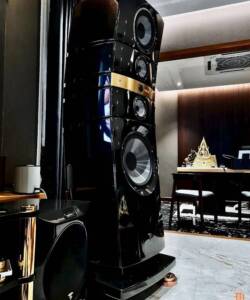Audience ClairAudient 16
Original price was: R680,000.00.R88,000.00Current price is: R88,000.00.
Please note this is the version with no rear facing drivers. Virtually the same design.
We love to look at high end speakers the way we like to look at Ferrari’s and Lamborghini’s. We can hope to hit the lottery and maybe buy one some day but we really never expect to get there. It doesn’t hurt to dream though. So, when Audience, makers of all sorts of “high end” gear from power conditioners to power cords, announced that they had upgraded their ClairAudient 16+16 speaker, we decided to press our noses against the glass to see what we wouldn’t be able to afford.
The new Mark II versions of the ClairAudient 16+16 speakers have added passive radiators to the original line-source design. Line-source speakers are easy to identify by their (usually) tall enclosures and huge rows of smaller drivers. The ClairAudient 16+16 is no different. They sport 32, 3″ anodized aluminum-magnesium alloy cone drivers in each speaker. The speaker has a tear-drop shape with 16 of the drivers facing forward and 16 of them on one of the angled back side. This creates a bi-pole design. While not specified (or shown in any pictures), we believe the passive radiators must be on the second angled rear panel.
While the original ClairAudient 16+16 speakers were spec’d flat down to 80Hz, the passive radiators bring this response down to 30Hz for a true, full-range speaker. The newly upgraded A3-S2 drivers feature a large, patented neodymium-magnet motor structure and a curvilinear shape and concave dust cap designed to control high-frequency cone breakup and provide optimum dispersion.
One of the advantages of a line-source design is the complete lack of crossover. This is said to eliminate any problems that typically arise from the crossover points between the woofer/midrange/tweeter. This is typically the problem with traditional speaker designs and can compromise linearity if the crossover isn’t implemented correctly. By eliminating the crossover, such issues are said to be completely avoided
John McDonald’s Audience company has developed a range of speakers using a proprietary 3” cone driver to cover the complete audio range. The flagship Clairaudient 16+16 ($72,000/pair) made its debut at the Newport Beach Show. Each Clairaudient 16+16 uses 16 of the latest-generation drivers firing to the front and another 16 to the back, and is specified to be flat to 30Hz.
Read more at https://www.stereophile.com/content/audience%E2%80%99s-clairaudient-1616-mkii#IZC6Kceuav54yw6t.99
Bam-bam! Avant-garde Territory Once Again
A guy schleps along month after month with nothing dramatic to report and then, wham! Twice in the space of six weeks or so the same dorky guy comes face to face with the Audio Avant-garde. In one sense, my second “close encounter” with the outer reaches of audio reproduction had a slow take off. It began twelve years ago or so.
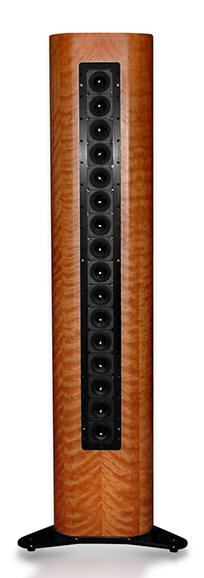 Richard Smith and John McDonald at Audience frequently invited me, across many years, to drop by their work place to audition the newest iteration of their evolving line array speakers. On numerous occasions I did just that. In fact, the interview with Richard Smith, posthumously published several years ago in this journal, derived from one of those listening sessions.
Richard Smith and John McDonald at Audience frequently invited me, across many years, to drop by their work place to audition the newest iteration of their evolving line array speakers. On numerous occasions I did just that. In fact, the interview with Richard Smith, posthumously published several years ago in this journal, derived from one of those listening sessions.
Sadly, for Richard, my shared assessments of his line array speaker work was, for the most part, divided (on one side) by sincere encouragement that he and John not abandon their exhausting revisions and (on the other side) by somewhat discouraging evaluations.
Nevertheless, Richard—who was an indefatigable audio designer—remained optimistic, as he should have, and bravely focused on perfecting his speaker work. To his very end, Richard stayed firm and true to his belief that he was on the right path. One could hear justifications for his faith each and every time a new advance in the line array design was ready for auditioning.
It is a testimonial to Richard’s career and to his partner John McDonald’s loyalty and good faith (and astute judgment) that those long years of revision have now come to complete fruition with the additional work of Roger Sheker and new A3 drivers (to be discussed in a future moment).
My recent Audience “avant-garde” experience was prefaced a year and a half ago, at CES in Las Vegas, when I heard the large ClairAudient line array speakers at a level of performance that motivated me to publish a glowing review. Harry Pearson and I separately heard the Audience set up within half an hour or so of one another. I noted to Harry, soon afterward, that I heard a degree of audio transparency in the Audience speakers that outflanked any speaker I’d heard to date—at least, that outflanked any genuinely musical speaker, since on occasions I’ve encountered marvelously open and transparent panel speakers with restricted range that reduced the full measure of their potential musicality. Harry, as I recall, agreed heartily and noted that the ClairAudient line array actually revealed sonic details of his test disc (Holst’s Planets) he’d never previously discerned.
That CES experience with the big Audience line array was just a warm up to my recent cavorting with their ultimate incarnation—an ultimate and wildly successful arrival at the threshold of musical sexuality.
Horrible term, right? “Musical sexuality”… but, then, that’s exactly what, across nearly five continuous hours of hearing my own master recordings, I stumbled upon—as if a bulky old bloke, who lives with the demented illusion of his own permanently-arrested twenty five year old self, can encounter not so much his own youthful pulchritude as the never-waning seductiveness and vibrant sexual tug of live music created hilariously by great musicians and reproduced, hilariously with tactile force, by extraordinary (avant-garde) speakers.
That’s what these newly crafted, supremely buffed and tweaked ClairAudient “LSA 16+16” bi-pole speakers concoct: tactile musical force of a sort that makes it impossible for any music lover not to be sucked in, swept up, and transformed emotionally into immediate proximity with surging musical grooves and lyrical kaleidoscopes of shifting melodic shapes.
If that’s not an elegant, wholly innocent form of “musical sexuality,” what the hell is?
Listening to these bi-pole speakers—no sub in the mix; Audiences’ cables and mono-block amps plus an Audience preamp (fed by a seriously modified Denon transport)—was as close to a poignant aesthetic orgasm as anyone (at any age) is likely to blissfully endure in utter isolation.
The Second Time’s Another Charm
Now add to Kubala-Sosna’s Elation cables another contender for products you might not want to persevere musically without… since the Audience ClairAudient LSA 16+16 bi-pole line array is the Elation’s companion-in-exile, a transcendent, utterly revealing sonic partner waiting in the wings.

The Audience ClairAudient Loudspeaker: A 20-Year Dream Realized
Robert Harley
On a recent visit to Southern California, I stopped in to see Audience, maker of a highly regarded line of AC power-conditioner and signal cables. During the visit, however, I discovered that Audience is much more than a cable and power-conditioner manufacturer.
Back in the late 1980s, Audience founder John McDonald and his then partner, the late Richard Smith, conceptualized what they viewed as the ideal loudspeaker. The exercise was more of a “what if” thought experiment rather than a concrete design brief. Their idealized speaker would use many small, identical full-range drivers in a line-array, which confers the advantage of needing no crossover. Each driver would reproduce the entire frequency spectrum, although without much acoustic output. Multiple drivers would increase the power handling, dynamics, and ability to play loudly. A crossover-less speaker had the advantage of no discontinuity between drivers, uniform polar response, and no inductors or capacitors in the signal path between the power amplifier and the loudspeaker drivers.
This approach sounded intriguing, but no driver was available that could reproduce the entire audio band and have enough power handling and excursion to produce adequate listening levels. Over the past 20 years, Audience has worked on-and-off to develop such a driver, but recently put forth their full effort. The result is the Audience A3 3” driver, the foundation for the entire eight-product ClairAudient line of loudspeakers. Every speaker in the line uses only the A3 driver, with the differences between speakers simply being the number of drivers employed.
Audience Chief Engineer Roger Sheker and Audience Founder John McDonald with the A3 driver
The A3 is a very interesting device; its basket, motor structure, and diaphragm are unlike other similarly sized units that are used as midrange drivers. Instead, the A3 is built just like a subwoofer driver, but miniaturized. The unit has an open basket design, neodymium magnet, only 2.5 grams of moving mass, and an extraordinary 12mm excursion. The motor is patented, and the surround and basket are patent-pending. Frequency response is 40Hz–22kHz.
 The ClairAudient line includes eight models, ranging from the $9500 four-driver LS4 to the $47,000 32-driver LSA16+16. The model number indicates the number of drivers employed. Each model is available as a monopole with all drivers front-firing (LSA4, for example), or as a bipole with an identical driver array on the side/rear panel (LSA4+4, to continue the example). The LSA4+4 has a sensitivity of 93dB and a maximum continuous output level of an astounding 121dB. The LSA16+16’s sensitivity is a whopping 99dB with a maximum continuous output level of 128dB. (Audience is about to introduce a two-driver version, called the LSA2 at “under $2000,” and the bipole LSA2+2 at “under $4000.”)
The ClairAudient line includes eight models, ranging from the $9500 four-driver LS4 to the $47,000 32-driver LSA16+16. The model number indicates the number of drivers employed. Each model is available as a monopole with all drivers front-firing (LSA4, for example), or as a bipole with an identical driver array on the side/rear panel (LSA4+4, to continue the example). The LSA4+4 has a sensitivity of 93dB and a maximum continuous output level of an astounding 121dB. The LSA16+16’s sensitivity is a whopping 99dB with a maximum continuous output level of 128dB. (Audience is about to introduce a two-driver version, called the LSA2 at “under $2000,” and the bipole LSA2+2 at “under $4000.”)
I listened to the LSA4+4 and the LSA16+16 in John McDonald’s home listening room, driven by Audience’s new preamplifier and power amplifier. Although I was impressed by the A3 driver’s specifications and apparent capabilities before listening to the full speaker systems, I nonetheless had a preconceived idea that the system would not have much extension at the frequency extremes, and not play very loudly.
 The ClairAudient LSA4+4
The ClairAudient LSA4+4
 The ClairAudient LSA16+16 with the prototype LSA2+2 in front
The ClairAudient LSA16+16 with the prototype LSA2+2 in front
I was wrong on both counts. The LSA4+4 sounded like a full-range speaker in every way, but with a coherence and seamlessness that was undoubtedly due to the lack of crossovers and disparate drivers. The midrange was palpable and immediate without sounding forward or emphasized. The top end had a full measure of detail and resolution, without the lack of air and extension I’ve heard in the past from full-range drivers. But the most surprising aspects of the LSA4+4 were its bass and dynamics. The bottom-end exhibited real weight and body, with a wonderful palpability of instrumental texture on acoustic bass. Similarly, they system was very quick, dynamic, and agile, with impact behind musical peaks.
Switching to the LSA16+16 reinforced these impressions; the big speaker had all these qualities but in greater abundance—the bass had more weight and power, the dynamics were more startling, and the soundstage became more expansive. The system didn’t reproduce the lowermost octave (20Hz–40Hz) with much authority, but Audience makes a matching woofer for those who value sub-40Hz response.
My audition was unfortunately quite brief, but in the short time I had with the two ClairAudient models, I was impressed by the top-to-bottom coherence, seamlessness, and sense of transparency—over and above my surprise at just how “full-range” the system sounded, along with its ability to play loudly without strain.
The ClairAudient loudspeakers have been more than 20 years in the making, but, at least from initial impressions, the effort has been worth it
Description
Line array 16 drivers
No crossover
99 db@ 1 watt.
16, 3″ anodized aluminum-magnesium alloy cone drivers in each speaker
